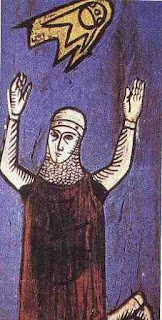This cave painting is from Tassili, Sahara Desert in North Africa. It dates back to 6000 B.C. The figures do not look human. Notice the flying disk in the sky.
This cave painting was found in Itolo, Tanzania. It's approx 29,000 yrs old. Notice the obvious
UFO-shaped objects as well as the objects which both of them appear to be dropping from the bottom.
This cave painting is also from Tassili, Sahara Desert in North Africa, 6000 B.C. This figure
also does not look human. Notice the same halo-looking object around the head that we see in
some of the other paintings from other parts of the world.
These cave paintings are from the area of the Glenelg River in Kimberly, Northern Australia. These photographs are taken from the book, “ Journals of Two Expeditions of Discovery in North-West and Western Australia 1837, 1838, & 1839”, by Lt. Grey. Lt. Grey led an expedition and came across these cave drawings. The local Aborigines know these figures as the Wandjina. Again, just as has been found all over the planet, notice the same halo-looking objects over their heads. Also, notice that other than the halo-type object, the eyes are the dominate features of these beings.
Illustrations from a 12th century manuscript Annales Laurissenses, a book that documents historical and religious events. These illustrations refer to a well-documented 776 A.D. UFO sighting in France. The Saxons were besieging the French Sigiburg Castle and had surrounded the town when a group of light-emitting disc-shaped objects, which they called “flaming shields”, suddenly appeared in the sky above the church. The Saxons took this “sign” to mean that these objects were there to protect the French and fled from the area.
This broadsheet painting, by Samuel Coccius, illustrates the flaming and "large black globes" that many witnesses reported to have seen in the skies over Basel, Switzerland in 1566. (From the Wickiana Collection, Zurich Central Library, Switzerland).
UFO sighting over Hamburg, Germany - November 4, 1697. The objects were described as being "two glowing wheels". Notice many people pointing - this was likely a famous event.
"Summer's Triumph" is a tapestry created in Bruges, Belgium in 1538 - Bayerisches National Museum. Several classic-shaped UFO-like objects are clearly depicted in the sky near the top. It is thought that the inclusion of these might have been politically motivated in effort to sway local opinion by associating UFOs with the current rulers in order to claim divine intervention in their political careers.
This illustration comes from the 10th century Tibetan translation of the Sanskrit text "Prajnaparamita Sutra", which is held at a Japanese museum. In the enlarged portion show two objects, which are reminiscent of the classical UFO shape, are in clear view. One of them appear to have some sort of holes. Indian Vedic texts are rich with descriptions of things they called Vimanasand, which are described as a double-decked, circular or cylindrical aircraft with portholes and a dome. It was said of them that they flew with "the speed of the wind" and gave forth a "melodious sound."
This is another 15th century tapestry which depicts scenes from the life of Mary. UFO-shaped objects can also be clearly seen it this one. This is also on display at the French Basillica Notre-Dame in Beaune, Burgandy.
This illustration, from the French book "Le Livre Des Bonnes Moeurs" by Jacques Legrand, housed in Chantilly Condé's Museum (ref 1338 ,297 part 15 B 8), has created much controversy. Some have said this is a balloon but balloons did not yet exist in France in 1338. This is difficult to therefore explain away, especially since many modern UFO sightings have been documented as being a sphere-like object.
This fresco entitled "The Crucifixion" was painted in 1350 and is now above the altar at the Visoki Decani Monestary in Kosovo, Yugoslavia. Two objects can be seen in the top left and top right of the artwork. The two enlargements of these objects reveal figures riding inside these unknown craft.



















No comments:
Post a Comment